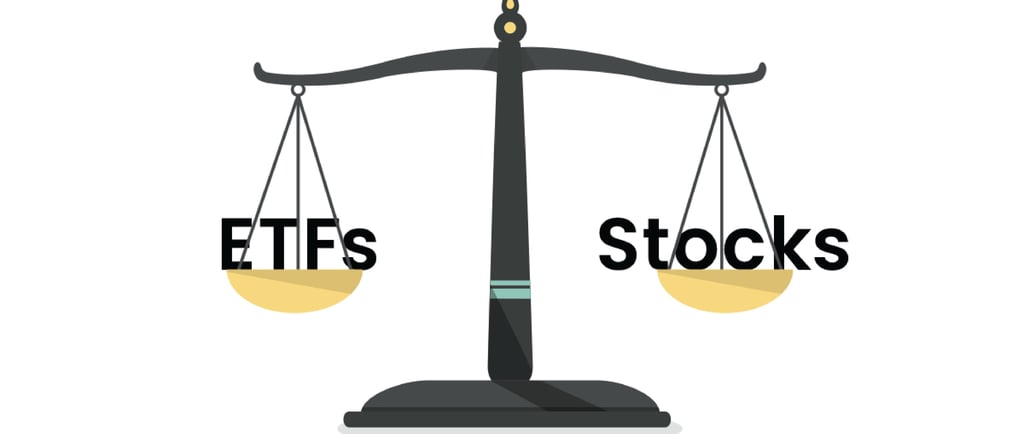ETFs vs. Stocks: Which Investment is Right for You?
Should you invest in ETFs or individual stocks? ETFs offer diversification and low risk, while stocks provide higher return potential but require more strategy. In this post, discover the key differences, when to choose each, and how to combine them for the best results! 🚀
ETF INVESTING FOR BEGINNERS
Christopher Skyler
10/9/20244 min read


Choosing the Right Investment: ETFs or Individual Stocks?
If you’re looking to grow your wealth through investing, you’ve probably asked yourself:
👉 “Should I invest in ETFs or individual stocks?”
Both can be powerful tools for building wealth, but they serve different purposes and require different strategies. One offers simplicity and diversification, while the other provides control and potentially higher returns.
So, which one is best for you? Let’s break it down.
1. What Are ETFs and How Do They Work?
🔹 What is an ETF?
An Exchange-Traded Fund (ETF) is a basket of investments (like stocks, bonds, or commodities) that you can buy and sell just like a stock. Instead of buying one company, an ETF allows you to invest in hundreds or even thousands of companies at once.
📌 Example:
S&P 500 ETF (like SPY or VOO) → Holds 500 of the largest U.S. companies (Apple, Microsoft, Tesla, etc.).
Vanguard Total Stock Market ETF (VTI) → Includes the entire U.S. stock market.
Global ETFs → Allow you to invest in international markets.
✅ Why People Love ETFs:
Diversification – Reduce risk by investing in multiple companies.
Lower risk – If one stock performs poorly, others in the ETF can balance it out.
Low effort – No need to research individual stocks—just invest and let it grow.
Lower fees – Much cheaper than mutual funds and actively managed portfolios.
2. What Are Individual Stocks and How Do They Work?
🔹 What is a Stock?
A stock represents ownership in a single company. When you buy shares of a company, you become a partial owner and benefit when the company grows.
📌 Example:
Buying Apple (AAPL) means you own a small piece of Apple Inc.
If Apple grows, your shares increase in value.
Some companies pay dividends, meaning you earn passive income.
✅ Why People Love Stocks:
Higher potential returns – Investing in the right company early can lead to massive gains.
More control – You choose exactly which companies to invest in.
Dividends – Some stocks pay you passive income every quarter.
3. ETFs vs. Stocks: Key Differences.
When comparing ETFs and stocks, there are clear distinctions that cater to different types of investors. Here's how they stack up:
Risk Level: ETFs carry lower risk because they are diversified, spreading your investment across multiple companies. Stocks, on the other hand, come with higher risk as they depend entirely on the performance of a single company.
Potential Return: ETFs offer moderate returns due to their diversification, while stocks have the potential for much higher returns if you choose a winning company.
Diversification: ETFs naturally provide diversification by including a basket of assets, reducing the impact of poor performance by a single company. Stocks lack this safety net, as your investment is concentrated in just one company.
Time Commitment: ETFs are ideal for passive investors because they require minimal ongoing research. Stocks demand a higher time commitment, involving research and monitoring to make informed decisions.
Best For: ETFs are perfect for beginners and long-term investors looking for steady growth with less effort. Stocks are better suited for experienced investors or active traders who are willing to put in the time to analyze and manage their portfolio.
📌 In Simple Terms:
ETFs are like buying a whole team of players—you don’t rely on one star to win.
Stocks are like betting on a single player—if they perform well, you win big; if they fail, you lose big.
4. When Should You Choose ETFs?
ETFs are perfect for:
✅ Beginners – No need for stock-picking expertise.
✅ Long-term investors – If you want steady growth without daily market monitoring.
✅ Risk-averse investors – If you want to minimize losses through diversification.
✅ Passive income seekers – Many ETFs offer dividend reinvestment.
Best ETFs for Beginners:
S&P 500 ETFs (SPY, VOO, IVV) – Invest in the 500 largest U.S. companies.
Total Stock Market ETFs (VTI, SCHB) – Covers the entire stock market for maximum diversification.
Dividend ETFs (VYM, SCHD) – Pays out steady passive income.
👉 If you want an easy, low-risk way to invest, ETFs are the best choice.
5. When Should You Choose Individual Stocks?
Investing in stocks is ideal for:
✅ Experienced investors – You understand company financials and market trends.
✅ Those seeking high returns – If you can identify winning stocks early.
✅ Dividend investors – If you want regular payouts from strong dividend-paying companies.
✅ Active traders – If you enjoy researching and following market movements.
Best Stock Strategies:
Growth Investing – Find companies that will expand significantly (like Tesla, Nvidia, or Amazon).
Value Investing – Buy strong companies at a discount (like Warren Buffett’s strategy).
Dividend Investing – Pick stocks that pay out consistent dividends (like Coca-Cola or Johnson & Johnson).
👉 If you love analyzing companies and want the potential for higher returns, stocks might be the better choice.
6. Can You Invest in Both? (The Best of Both Worlds)
Yes! In fact, most wealthy investors use a combination of ETFs and stocks to balance risk and reward.
📌 Example Portfolio Strategy:
✅ 70% in ETFs – For stable, long-term growth.
✅ 30% in individual stocks – To try and outperform the market.
This strategy ensures steady returns while still giving you the opportunity for high growth.
7. Final Verdict: Which One is Right for You?
Choose ETFs If You Want:
✅ A low-risk, easy investment strategy.
✅ Diversification without constant research.
✅ A hands-off investing approach.
Choose Individual Stocks If You Want:
✅ Higher potential returns (and accept higher risk).
✅ More control over what you invest in.
✅ To actively manage your portfolio and research companies.
💡 Want to build a smart investment portfolio?
📖 Get your copy of ETF Investing for Beginners to learn everything you need to start investing successfully!
© 2025 SkylerPublishing.com. All rights reserved.
